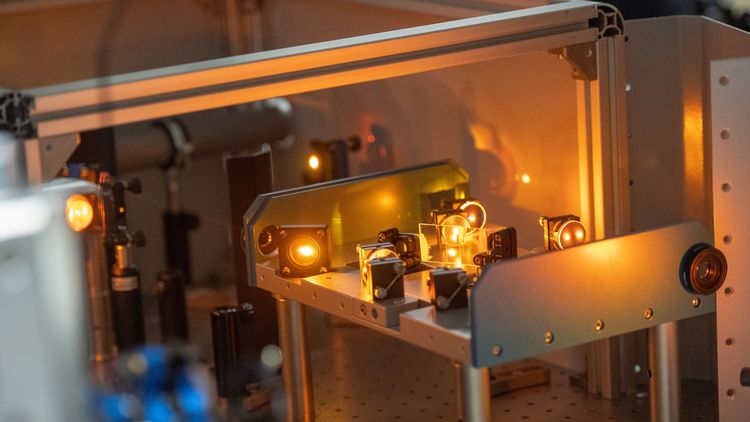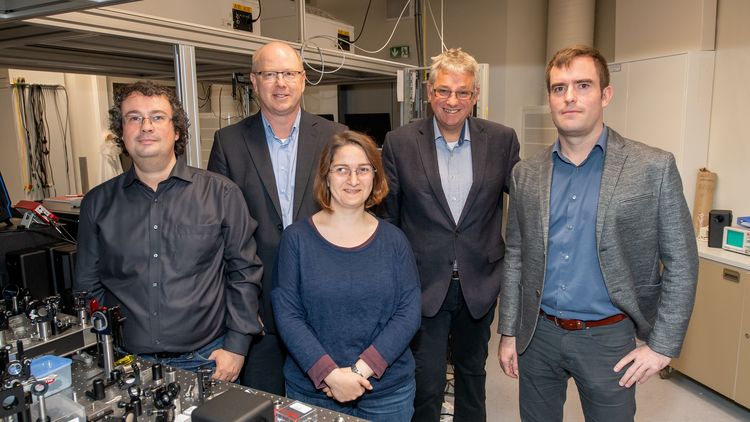In a new laboratory on the university’s Wechloy Campus, Oldenburg physicists are studying the movements of electrons inside atoms. The research conducted here will enable them to gain a better understanding of processes such as the generation of charge carriers in solar cells.
Behind an ordinary door on the third floor of Building W02 on Wechloy Campus is a laboratory like few others in the world. Visitors who want to enter must wear a plastic cap and special shoe covers. Shiny jewellery is taboo. But most importantly: if they need to bend down – for instance to retrieve a dropped pen – they are advised to do so with their eyes closed.
These precautions are necessary because the Institute of Physics’ new Attosecond Laboratory contains an extremely powerful laser. The laser’s white light beam transverses the room at hip height and is visible only when it hits an obstacle. Under no circumstances should the light beam shine into a person’s eyes. Any dust particles that cross the concentrated light beam can potentially be burned into objects. The laboratory is therefore fitted with six ventilation units to ensure that any lint or dust particles are swiftly transported outside.
Trillionths of a second
The secret at the heart of the new laboratory is that light pulses with a duration of just a few trillionths of a second are produced here. The ultra-short pulses make it possible to freeze and record processes that take place at incredible speed inside atoms, such as the conversion of electrons from one energy state to another. The laboratory was set up jointly by four research groups from the Institute of Physics at a cost of around two million euros. In the new facility, the scientists will for the first time be able to directly study processes similar to photosynthesis in plant cells or charge generation in solar systems.
“The laboratory offers access to new approaches in nanoscale microscopy,” Prof. Dr. Matthias Wollenhaupt reports. Wollenhaupt, head of the Ultrafast Coherent Dynamics research group (ULTRA), uses the Attosecond Laboratory together with his colleagues, Prof. Dr. Christoph Lienau, Prof. Dr. Sascha Schäfer and Prof. Dr. Niklas Nilius, and their research groups Ultrafast Nano-Optics (UNO), Ultrafast Nanoscale Dynamics (UND) and Scanning Tunneling Spectroscopy (Raspe). The laboratory is supervised by physicists Dr. Lars Englert and Dr. Antonietta de Sio.
Controlling the interaction between light and electrons
„In order to observe, understand and ultimately control the interaction between light and electrons, we need light pulses with a duration of just a few attoseconds, Wollenhaupt explains. Only in recent years has it become possible to generate such light pulses: one attosecond is just a billionth of a billionth of a second, i.e. a zero with 17 more zeros after the decimal point and before the one.
Many processes in the nanoworld, such as the movements of atoms and molecules, typically take place on a femtosecond time scale. One femtosecond is equivalent to several thousand attoseconds. However, the processes inside atoms or molecules are determined by electrons that are much smaller than atomic nuclei and move much faster. “The circulation time of an electron on the innermost orbit of a hydrogen atom in the famous Bohr atom model is only around 150 attoseconds," Lienau explains.
Adressing fundamental questions in physics
The centrepiece of the new laboratory is a state-of-the-art femtosecond laser system that is concealed under a black cover. The pulses it generates last around four femtoseconds. To generate even shorter attosecond pulses, the researchers collimate the laser light into a beam of inert gas. This produces light waves with an integer multiple of the original frequency. "It works in a similar way to when you play a string instrument," explains Wollenhaupt. "Here, too, in addition to the fundamental tone, higher tones are produced, the so-called overtones.” In the same way, the femtosecond laser pulses in the visible part of the light can be used to generate laser pulses in the extremely ultraviolet area of the spectrum that are less than 150 attoseconds long. With these short wavelength attosecond pulses, not only can the fast movements of electrons be traced, but extremely tiny structures such as individual atoms can be made visible – and the path of electrons within a solid thus tracked.
The researchers are currently putting the new laboratory into operation, acquainting themselves with the instruments and starting their first experiments. Here they are investigating fundamental physics problems as well as application-oriented questions. The physicists plan to study certain chemical reactions that are controlled by light, for example. They are also interested in energy and charge transfer in nanostructured materials. These materials, which at the microscopic level have structures such as pores or lattices, could serve as the basis for the solar cells of the next generation but one. (uk)




